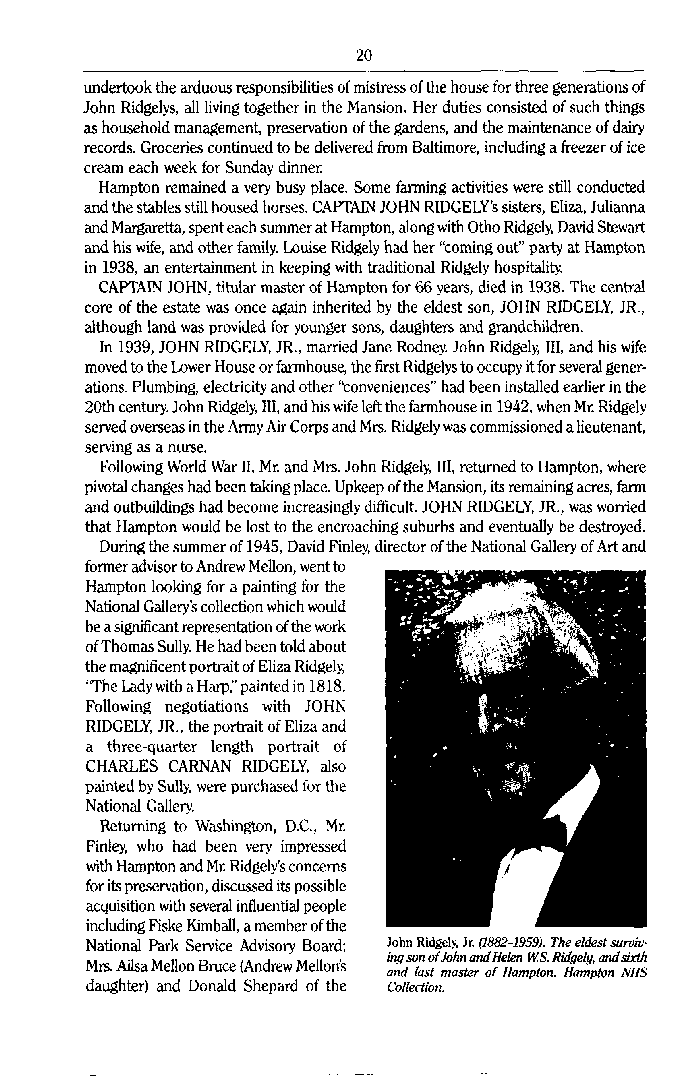|
20
undertook the arduous responsibilities of mistress of the house for three generations of
John Ridgelys, all living together in the Mansion. Her duties consisted of such things
as household management, preservation of the gardens, and the maintenance of dairy
records. Groceries continued to be delivered from Baltimore, including a freezer of ice
cream each week for Sunday dinner.
Hampton remained a very busy place. Some farming activities were still conducted
and the stables still housed horses. CAPTAIN JOHN RIDGELY's sisters, Eliza, Julianna
and Margaretta, spent each summer at Hampton, along with Otho Ridgely, David Stewart
and his wife, and other family. Louise Ridgely had her "coming out" party at Hampton
in 1938, an entertainment in keeping with traditional Ridgely hospitality.
CAPTAIN JOHN, titular master of Hampton for 66 years, died in 1938. The central
core of the estate was once again inherited by the eldest son, JOHN RIDGELY, JR.,
although land was provided for younger sons, daughters and grandchildren.
In 1939, JOHN RIDGELY, JR., married Jane Rodney. John Ridgely, III, and his wife
moved to the Lower House or farmhouse, the first Ridgelys to occupy it for several gener-
ations. Plumbing, electricity and other "conveniences" had been installed earlier in the
20th century. John Ridgely, III, and his wife left the farmhouse in 1942, when Mr. Ridgely
served overseas in the Army Air Corps and Mrs. Ridgely was commissioned a lieutenant,
serving as a nurse.
Following World War II, Mr. and Mrs. John Ridgely, III, returned to Hampton, where
pivotal changes had been taking place. Upkeep of the Mansion, its remaining acres, farm
and outbuildings had become increasingly difficult. JOHN RIDGELY, JR., was worried
that Hampton would be lost to the encroaching suburbs and eventually be destroyed.
During the summer of 1945, David Finley, director of the National Gallery of Art and
former advisor to Andrew Mellon, went to
Hampton looking for a painting for the
National Gallery's collection which would
be a significant representation of the work
of Thomas Sully. He had been told about
the magnificent portrait of Eliza Ridgely,
'The Lady with a Harp," painted in 1818.
Following negotiations with JOHN
RIDGELY, JR., the portrait of Eliza and
a three-quarter length portrait of
CHARLES CARNAN RIDGELY, also
painted by Sully, were purchased for the
National Gallery.
Returning to Washington, D.C., Mr.
Finley, who had been very impressed
with Hampton and Mr. Ridgely's concerns
for its preservation, discussed its possible
acquisition with several influential people
including Fiske Kimball, a member of the
National Park Service Advisory Board;
Mrs. Ailsa Mellon Bruce (Andrew Mellon's
daughter) and Donald Shepard of the
John Ridgely, Jr. (1882-1959). The eldest surviv-
ing son of John and Helen W.S. Ridgely, and sixth
and last master of Hampton. Hampton NHS
Collection.
|

